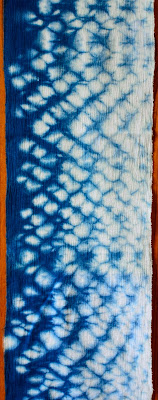I really ought to finish the boro quilt, but my own shibori indigo dyed fabrics have been calling for too long, and I couldn't resist starting the medallion quilt that's been on my mind for the past several months:
I dyed the center panel back in the summer, and I've been envisioning a medallion quilt ever since. The center is an itajime variant that combines origami-like folding with clamped resists--it's sort of like folding and cutting paper snowflakes. I used Osnaburg cotton, a fairly rough and loose weave of cotton, combined with a lot of massaging of the fabric while in the vat, in order to maximize dye penetration. The rest of the fabrics come from both this summer's and last summer's indigo dyeing extravaganzas.
Currently, the top is about 28" square. I don't know how many more rounds I'm going to do, but I'm guessing that it will finish at about 40-48" square. Here's a hint of the next round, which will take me a while to put together:
Linking up to WIP Wednesday on The Needle and Thread Network and Freshly Pieced. Happy sewing, everyone!
I dyed the center panel back in the summer, and I've been envisioning a medallion quilt ever since. The center is an itajime variant that combines origami-like folding with clamped resists--it's sort of like folding and cutting paper snowflakes. I used Osnaburg cotton, a fairly rough and loose weave of cotton, combined with a lot of massaging of the fabric while in the vat, in order to maximize dye penetration. The rest of the fabrics come from both this summer's and last summer's indigo dyeing extravaganzas.
Currently, the top is about 28" square. I don't know how many more rounds I'm going to do, but I'm guessing that it will finish at about 40-48" square. Here's a hint of the next round, which will take me a while to put together:
Linking up to WIP Wednesday on The Needle and Thread Network and Freshly Pieced. Happy sewing, everyone!









































